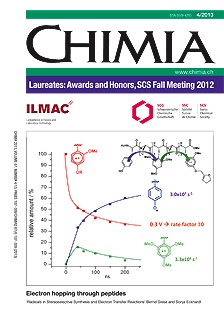Probing Electronic Dynamics during Photochemical Reactions
DOI:
https://doi.org/10.2533/chimia.2013.207Keywords:
Attosecond spectroscopy, Conical intersections, High-harmonic generation, Photodissociation, Transient gratingAbstract
This review discusses a new method for probing the evolution of the valence-electron structure of molecules during chemical reactions. The method relies on the interaction of an intense infrared laser pulse with molecules that results in the emission of attosecond pulses (1 as = 10–18 s) in a process known as high-harmonic generation. Time-resolved high-harmonic spectroscopy measures the phase and amplitude of attosecond pulses emitted from the reacting molecules through interference with the emission from the unexcited molecules. This coherent detection mechanism provides a high sensitivity to small excitation fractions and direct access to both the amplitude and the phase of attosecond pulses, the latter of which is otherwise very difficult to measure. These observables reveal several complementary aspects of excited-state photochemical dynamics such as dissociation, adiabatic wave-packet evolution and conical intersection dynamics.Downloads
Published
2013-04-24
Issue
Section
Scientific Articles
License
Copyright (c) 2013 Swiss Chemical Society

This work is licensed under a Creative Commons Attribution-NonCommercial 4.0 International License.
How to Cite
[1]
A. Tehlar, P. M. Kraus, H. J. Wörner, Chimia 2013, 67, 207, DOI: 10.2533/chimia.2013.207.







